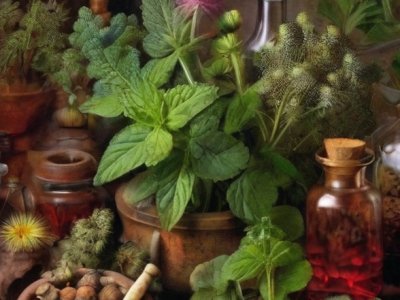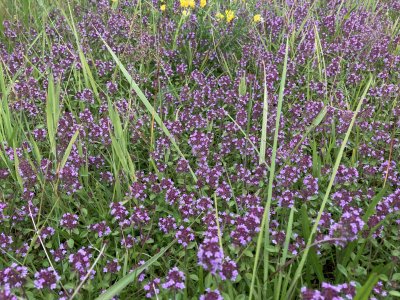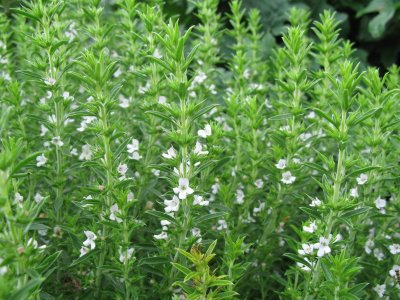Ancient Egyptian uses of aromatic plants
Therapeutic use issues/
18.02.24

SOME PLANTS USED IN ANCIENT EGYPT WITH THEIR POTENTIAL
MEDICINAL PROPERTIES
By Martin watt
Written for the benefit of the participants on an aromatherapy trip to
Egypt.
Important note: When this was written it was mainly an article about the
herbs. Therefore, do not assume all the comments are applicable to a distilled
oil.
CHAMOMILES: There is evidence that some varieties were available in the
region of the Nile, but precisely how they were used is still uncertain. However,
it is clear from ancient texts that many medicinal plants were widely grown, as
well as imported into ancient Egypt. It is therefore likely that some of the
medicinal properties of the chamomile's were known and appropriate use made
of them.
Modern research has shown that a hot water extract of Matricaria chamomilla
has an antibacterial effect. It completely inhibits the growth of Staph. aureus,
Streptococcus strains, Leptospira and Trichomonas. Leptospira are particularly
nasty organisms, they are carried by rats and can enter the body through skin
abrasions when working in contaminated water. Due to the extensive irrigation
networks in Egypt, it is very likely to have been a common illness and perhaps
they knew how to treat it.
Matricaria oil can exert a strong anti-inflammatory effect due to the a-
bisabolol present in high amounts in some oils, this compound has been
proven to exert a powerful anti-inflammatory effect on damaged skin,
especially when the skin has been weakened and cracked by exposure to
strong sunlight.
Anthemis nobilis oil has been confirmed as having powerful anti-
inflammatory actions as well as exerting a strong sedative effect when
administered internally.
CELERY seed and stem: The stem has been found to have anti-inflammatory
activity when consumed as a food, and the research team suggested it may be
helpful for rheumatic disease and arthritis (prevalent in pyramid builders). The
seed oil has been shown to produce a mild increase in urine flow when used
internally in tests on dogs. Herbalists have traditionally used alcoholic extracts
and whole celery seeds for arthritic problems, but it is nice to get modern
confirmation that we were correct. Celery seed OIL is only mildly active against
a few bacteria, but when combined with other oil bearing plants it has a
cumulative effect in enhancing food preservation.
CORIANDER: This plants OIL has been shown to have mild anti-bacterial
properties and moderate anti-inflammatory actions if applied locally. It has also
been used as a carminative for spasms of the gastro-intestinal tract.
GARLIC: Its medicinal properties have long been recognised, some say the
pyramids could not have been built without it. Certainly one of the first
recorded labour strikes was among the tomb builders in the valley of the Kings.
They marched on mass to the temples when hard times saw a reduction in
their rations of which garlic was an essential part.
JUNIPER: Tests were conducted in Italy in 1987 to establish the anti-
inflammatory activity of 75 plants used in traditional medicine. These tests
showed that juniper berries extracted in alcohol (which was then removed)
exhibited a 60% inhibition of inflammation against a 45% inhibition by the
drug indomethacin.
Juniper was used to alleviate headaches in Egypt, usually combined with other
water extracts of plants with known anti-inflammatory action. It is possible
that since some headaches result from dilation of temporal arteries, that
application of these mixtures would soothe the inflammation, reduce the
dilation and thereby reduce or stop the headache.
a-& b-pinene & borneol, both constituents of juniper berry and leaf oils, are
bactericidal.
ROSEMARY: Sprigs of rosemary were found in Egyptian mummy wrappings,
perhaps as an offering for the afterlife, or as a token preservative ? A
component of rosemary has been demonstrated to have a powerful anti-
oxidant effect (preservative). Rosemary OIL has mild anti-bacterial activity and
Moroccan rosemary has been shown to have a moderate activity against
pathogenic fungi.
WORMWOOD: The vapour of this plant was inhaled to stop a cough. Tests
conducted in 1987 demonstrated that as well as possessing anti-bacterial
activity; the OIL also has a very powerful anti-spasmodic activity. It must be
emphasised that the Egyptians did not - as far as we know - use
distilled oils, therefore the use of the plant in the manner described is safe,
but inhalation of pure wormwood oil is not recommended as it could have toxic
effects.
In 1988, research was undertaken in Iraq into the medicinal activity of
Wormwood. This was because it was widely used in traditional medicine to
treat diabetes mellitus. It was shown that oral administration of an aqueous
extract did in fact produce a significant fall in blood sugar levels.
Wormwood extracts have long been used by Medical Herbalist's for their potent
worm expelling properties. As infestation of the gut with parasitic worms is
common in societies with primitive sanitation, then it is very likely the ancients
were well aware of the effects of this plant.
Finally, there is not space here to go into great detail on all the medicinal,
perfumery and culinary uses of the wide range of plants available to the
ancient Egyptians. As more scientific investigations are completed, it is
becoming increasingly clear that they had a sophisticated system of medicine
and almost certainly were fully aware of the medicinal properties of a wide
range of herbal remedies. Indeed, they may even have possessed some potent
remedies, that even now science can not improve on.
Further reading:
"An Ancient Egyptian Herbal" by Lisa Manniche. I.S.B.N. 0-7141-1704-8
"An Enquiry into Plants" by Theophrastus of Lesbos 370 BC.
Source and copyright: aromamedical.org
291
More posts


